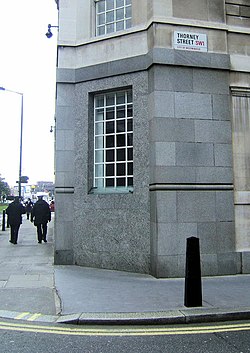Thorney Island, Middlesex

Thorney Island was a small marsh island on the Middlesex bank of the River Thames, upstream of mediæval London, and the place where Westminster Abbey and the Palace of Westminster were built. The island was formed between two branches of the River Tyburn, the river dividing to enter the Thames in two separate streams, forming an island in the ground between the two streams and the Thames.
In Roman times (and presumably before), Thorney Island may have been part of a natural ford where what was later called Watling Street crossed the Thames,[1] of particular importance before the construction of London Bridge.
Early history
The name of the island is Old English: Þorn ieg meaning "Thorn Island".

Thorney is described in a purported charter of King Offa, which is kept in the Abbey muniments, as a "terrible place".
A monastic community was installed here by King Edgar, which continued for 300 years, despite hardships and Viking raids, until the days of Edward the Confessor. It was the monks presumably who cleared the thorns from Thorney, and in the Confessor's day it was "A delightful place, surrounded by fertile land and green fields". The Abbey's College Garden[2] remains delightful, a thousand years later, possibly the oldest garden in England. King Edward built a new abbey here: today's Westminster Abbey.
In this place, west of the crowded alleys of the City of London, later kings developed the Palace of Westminster. In the precincts of Westminster Abbey was built too the Sanctuary or the Belfry, which was one of the great buildings of Westminster until its dilapidated structure was demolished in the 18th Century. (The Middlesex Guildhall stands on the spot today.)
Modernity
Thorney is an island no longer. The level of the land has risen, the streams of the Tyburn have been diverted, culverted and built over, and the Thames has been embanked. There is now no sign of Thorney Island. The name is kept only by Thorney Street, at the back of the 'MI5' Security Service building. A local heritage organisation established by June Stubbs in 1976 took the name The Thorney Island Society.
In 1831 the boundaries of the former island were described as the Chelsea Waterworks, the Grosvenor Canal and the ornamental water in St James's Park.[3]
Thorney Island is one of the places reputed to be the site of King Canute's demonstration that he could not command the tides, because he built a palace at Westminster. The location may be doubted because it is a long way inland, albeit still with tidal water.
Outside links
- Location map: 51°29’54"N, 0°7’44"W
- The Thorney Island Society
References
- ↑ "Loftie's Historic London (review)". The Saturday Review of Politics, Literature, Science and Art 63 (1,634): 271. February 19, 1887. https://books.google.com/books?id=m1RJAQAAMAAJ&pg=PA271. Retrieved October 2015.
- ↑ Westminster Abbey College Garden.
- ↑ Comparative account, 1831